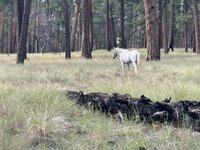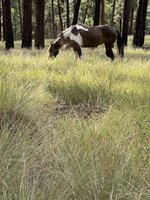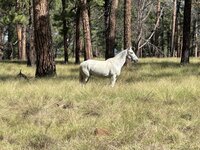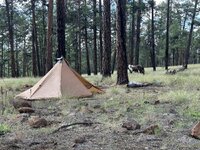yycyak
WKR
- Joined
- Apr 1, 2018
- Messages
- 317
TRIP – OCT/24
####
Edit: Usual "I don't know what I'm doing. I'm not an expert. Probably don't do what I do." etc.
It was a busy week this last week, so was only able to get the horses out for a trip on Friday. I know, I know:

But this time out I had things planned a little differently. My intention was this trip was a training trip, not a hunt. My goal: We were doing a water crossing, without drama. And if it took 4 hours to figure it out, well, it took 4 hours. And I'd hunt with whatever time was left in the day.
Armed with the Rokslide Collective’s tips on how to pony, plus a summarized version of @missjordan 's post written on a sticky note, I got the horses loaded into the trailer, and off we went.
Sticky Note, for reference later

Friday was the season opener for everything local here, and it was a zoo out there. Every trailhead and public land approach had trucks galore there. But that was okay – Training trip, remember.
After an hour or so of driving, got to the trailhead where I had issues with the water crossing before. (6x trucks parked at that trailhead too.) Got the horses unloaded and tacked up without issue. Time to mount up.
And of course, here I run into my usual How-To-Mount-While-Ponying issue. But this time I came prepared. I got the mare set up at the 2-o’clock position, with the lead rope over the saddle horn. Got the gelding’s reins in my left hand, lightly grab saddle horn, mount, bam. No issues. Start walking, let lead rope slide out around saddle horn, done. Dragon slain.

The entourage and I make it down to the river bottom. I have the idea that I’ll cross the same way I did last time: walk on foot across a bunch of riffle sections, get to one 10ft-across, knee-deep section, mount, and cross. Worked last time without an issue, so shouldn’t be an issue this time, right?
Wrong. Gelding says no way.
NEXT
So here’s where a guy might get a bit frustrated or rattled, but I had my trusty sticky note. (I also had suspected I'd be dealing with refusals after how the other week went.)
Side-note: I do this exercise a lot with my horses, with the end goal of getting them to calmly walk over a noisy blue tarp, or post, or other scary things. You basically plant yourself about 5ft off a fence, and send your horse between you and the fence. Key part: you don’t move your feet, ever. Your horse needs to go calmly between you and the fence, without crowding your space.
For those of you in the horse world, I realize there’s a ton of different names for this exercise that the various “Guru’s” out there use. For those of you not in the horse world, here’s 2x videos that show how it’s done. (Go youtube whomever you want to learn from - It's all the same stuff anyway.)
So between this and my sticky note, I had a game plan.
Now I wasn’t going to get too grumpy here. The gelding is a young 5, and lived his life on a flat-land hutterite colony. Mountains and rivers are maybe not quite on his thing (yet.) But, he's also crossed rivers and creeks before, and knows he won't die. I mean we walked this exact same one last week without him dying, so he knows what's up.
Long story short, I plant my feet about 5ft away from the river, and start sending him back and forth between me and the river. At first he dodges the water, but slowly his feet get closer to the river. I move to 4ft. Now his feet hit the water. Initially he does the WTF thing, but gets through it.
We repeat this a bunch until he figures out if he stops in the water (about 1ft deep), he gets to chill a bit. He eventually drops his head, has a drink, and chills out.
The rest of this part is anticlimactic. We do this exercise in three different spots on the riverbank, and eventually he is doing 8ft circles around me on the lead rope, in water, out of water, in water, out of water.
NEXT
At some point though you have to stop doing groundwork, and get riding. So, same drill as before: Mare at 2 o’clock, lead rope around saddle horn, mount, done. Almost look like I know what I’m doing. (Laughs in insecurity.)
No cheating at the short 10ft section - We head over to the full-on main crossing part of the river 90ft+ or something. We get to about 2ft away from the water, and refusal. He won’t go forward. Turns away to the left – I turn him right. Turns right – I turn him left. Don’t like the water – Too bad, we are facing it.
The spinning and turning stop. Now, it’s just the gelding planting his feet, and not doing anything.
No surprise here, and in anticipation of this exact thing I had done the old “Phone A Friend” trick. In this case the friend was an outfitter out of the Yukon, and she gave me some cowboy tricks that have worked for her critters in the past.
** So this part I suppose isn’t politically correct, but it’s here so that people can learn. I wish I’d known it earlier, and sure would have been grateful to have this info posted somewhere. But also, don’t be an idiot – Know your limitations, know your horses. This stuff can get you into a bad place quick if you use it the wrong way. Peter Parker, Uncle Ben, "Great Power, Great Responsibility" etc. Be safe out there, and know the difference between genuine fear response vs being stubborn. **
NEXT
I don’t like split reins, because I’m mostly an uncoordinated fool with them. I always wind up with a messed up bridge and reins way too long. But, for stuff like this, a set of heavy leather split reins can be used as a sort-of over-under, for when horses are being bratty and/or stubborn, and decide they don't want to move forward. So for this trip, I ran my DIY 3/4" leather 8ft split reins that are ugly as sin, but mostly work.
You need a horse to go forward when they don’t want to? Take your split-reins in your right hand, and do a quick left-right-left-right thrash with them over your horse’s bum. Not being abusive, or mean, or anything emotional (If you’re emotional doing this, you’re doing it wrong, and you're going to have a wreck probably.) It’s a quick “Hey, I’m onto your game here horse. You’ve been asked, now you’re being told.” I can’t really explain how to do this in an internet post – It's done by feel.
Key point: As soon as your horse goes forward just the tiniest bit, STOP. Again, you’re not being a jerk or "Teaching a lesson" or anything like that. You're doing the Pressure-Release thing. Forward movement = Instant release of pressure.
(Side comment: why not spurs? Turns out if you use spurs poorly, you’re more likely to get a rearing pony. Bad news bears when you're on a riverbank full of large rocks.)
NEXT
So here we go. Smoochie noise, then slight leg pressure. Nothing. Heavy leg pressure. Nothing. Okay, time to try it. Smoochie noise, leg pressure, then Split reins + butt smacks = Gelding going "Holy hell what was that!" and I get a big movement forward. All pressure off. Gelding's front legs are in the water now. Progress.
Ok, try again. Smooch, nothing. Leg pressure, nothing. Pick up split reins = Small step forward. Drop reins, all pressure off. Okay, more progress. He's made the connection between not moving forward and split rein tails. (Note I said "Pick up reins." Literally just picked the tails up with my right hand. Nothing else was needed.)
This song and dance repeats until we are about 7ft into the river, at which point the gelding drops his head, sticks his nose in the water for a bit, blows out, and starts putting one foot in front of the other. I give him a loose rein, and he finds his way across without issue. Huge win, and I'm feeling pretty good at this point.
NEXT
We get across the river (lots of praise once we get there) and the gelding isn't stopping - He goes straight up the bank, carrying my chunky carcass up the hill with him. We get to the top, and take a break. Lots of pets and praise. I look at my watch: killed 1.5hours doing this. Oh well. Still have the rest of the day. Off we go.
This stage of the day was mostly uneventful. We crossed a meadow, and started heading up the valley along an old game trail. I got off and walked a few times just to give the gelding a break. I also take time to pick up and play with the split reins, showing that they aren't a whip/thing to be scared of. Eventually we get to a decent spot up deep in the valley bottom where I can glass things and look for sheep.
I tie the horses up to some scrub poplar, and give them some oats. They stand around eating, while I sit on top of one of my junker panniers and look at rocks for two hours.



***
Part 2 next (ran out of characters)
####
Edit: Usual "I don't know what I'm doing. I'm not an expert. Probably don't do what I do." etc.
It was a busy week this last week, so was only able to get the horses out for a trip on Friday. I know, I know:

But this time out I had things planned a little differently. My intention was this trip was a training trip, not a hunt. My goal: We were doing a water crossing, without drama. And if it took 4 hours to figure it out, well, it took 4 hours. And I'd hunt with whatever time was left in the day.
Armed with the Rokslide Collective’s tips on how to pony, plus a summarized version of @missjordan 's post written on a sticky note, I got the horses loaded into the trailer, and off we went.
Sticky Note, for reference later

Friday was the season opener for everything local here, and it was a zoo out there. Every trailhead and public land approach had trucks galore there. But that was okay – Training trip, remember.
After an hour or so of driving, got to the trailhead where I had issues with the water crossing before. (6x trucks parked at that trailhead too.) Got the horses unloaded and tacked up without issue. Time to mount up.
And of course, here I run into my usual How-To-Mount-While-Ponying issue. But this time I came prepared. I got the mare set up at the 2-o’clock position, with the lead rope over the saddle horn. Got the gelding’s reins in my left hand, lightly grab saddle horn, mount, bam. No issues. Start walking, let lead rope slide out around saddle horn, done. Dragon slain.

The entourage and I make it down to the river bottom. I have the idea that I’ll cross the same way I did last time: walk on foot across a bunch of riffle sections, get to one 10ft-across, knee-deep section, mount, and cross. Worked last time without an issue, so shouldn’t be an issue this time, right?
Wrong. Gelding says no way.
NEXT
So here’s where a guy might get a bit frustrated or rattled, but I had my trusty sticky note. (I also had suspected I'd be dealing with refusals after how the other week went.)
Side-note: I do this exercise a lot with my horses, with the end goal of getting them to calmly walk over a noisy blue tarp, or post, or other scary things. You basically plant yourself about 5ft off a fence, and send your horse between you and the fence. Key part: you don’t move your feet, ever. Your horse needs to go calmly between you and the fence, without crowding your space.
For those of you in the horse world, I realize there’s a ton of different names for this exercise that the various “Guru’s” out there use. For those of you not in the horse world, here’s 2x videos that show how it’s done. (Go youtube whomever you want to learn from - It's all the same stuff anyway.)
So between this and my sticky note, I had a game plan.
Now I wasn’t going to get too grumpy here. The gelding is a young 5, and lived his life on a flat-land hutterite colony. Mountains and rivers are maybe not quite on his thing (yet.) But, he's also crossed rivers and creeks before, and knows he won't die. I mean we walked this exact same one last week without him dying, so he knows what's up.
Long story short, I plant my feet about 5ft away from the river, and start sending him back and forth between me and the river. At first he dodges the water, but slowly his feet get closer to the river. I move to 4ft. Now his feet hit the water. Initially he does the WTF thing, but gets through it.
We repeat this a bunch until he figures out if he stops in the water (about 1ft deep), he gets to chill a bit. He eventually drops his head, has a drink, and chills out.
The rest of this part is anticlimactic. We do this exercise in three different spots on the riverbank, and eventually he is doing 8ft circles around me on the lead rope, in water, out of water, in water, out of water.
NEXT
At some point though you have to stop doing groundwork, and get riding. So, same drill as before: Mare at 2 o’clock, lead rope around saddle horn, mount, done. Almost look like I know what I’m doing. (Laughs in insecurity.)
No cheating at the short 10ft section - We head over to the full-on main crossing part of the river 90ft+ or something. We get to about 2ft away from the water, and refusal. He won’t go forward. Turns away to the left – I turn him right. Turns right – I turn him left. Don’t like the water – Too bad, we are facing it.
The spinning and turning stop. Now, it’s just the gelding planting his feet, and not doing anything.
No surprise here, and in anticipation of this exact thing I had done the old “Phone A Friend” trick. In this case the friend was an outfitter out of the Yukon, and she gave me some cowboy tricks that have worked for her critters in the past.
** So this part I suppose isn’t politically correct, but it’s here so that people can learn. I wish I’d known it earlier, and sure would have been grateful to have this info posted somewhere. But also, don’t be an idiot – Know your limitations, know your horses. This stuff can get you into a bad place quick if you use it the wrong way. Peter Parker, Uncle Ben, "Great Power, Great Responsibility" etc. Be safe out there, and know the difference between genuine fear response vs being stubborn. **
NEXT
I don’t like split reins, because I’m mostly an uncoordinated fool with them. I always wind up with a messed up bridge and reins way too long. But, for stuff like this, a set of heavy leather split reins can be used as a sort-of over-under, for when horses are being bratty and/or stubborn, and decide they don't want to move forward. So for this trip, I ran my DIY 3/4" leather 8ft split reins that are ugly as sin, but mostly work.
You need a horse to go forward when they don’t want to? Take your split-reins in your right hand, and do a quick left-right-left-right thrash with them over your horse’s bum. Not being abusive, or mean, or anything emotional (If you’re emotional doing this, you’re doing it wrong, and you're going to have a wreck probably.) It’s a quick “Hey, I’m onto your game here horse. You’ve been asked, now you’re being told.” I can’t really explain how to do this in an internet post – It's done by feel.
Key point: As soon as your horse goes forward just the tiniest bit, STOP. Again, you’re not being a jerk or "Teaching a lesson" or anything like that. You're doing the Pressure-Release thing. Forward movement = Instant release of pressure.
(Side comment: why not spurs? Turns out if you use spurs poorly, you’re more likely to get a rearing pony. Bad news bears when you're on a riverbank full of large rocks.)
NEXT
So here we go. Smoochie noise, then slight leg pressure. Nothing. Heavy leg pressure. Nothing. Okay, time to try it. Smoochie noise, leg pressure, then Split reins + butt smacks = Gelding going "Holy hell what was that!" and I get a big movement forward. All pressure off. Gelding's front legs are in the water now. Progress.
Ok, try again. Smooch, nothing. Leg pressure, nothing. Pick up split reins = Small step forward. Drop reins, all pressure off. Okay, more progress. He's made the connection between not moving forward and split rein tails. (Note I said "Pick up reins." Literally just picked the tails up with my right hand. Nothing else was needed.)
This song and dance repeats until we are about 7ft into the river, at which point the gelding drops his head, sticks his nose in the water for a bit, blows out, and starts putting one foot in front of the other. I give him a loose rein, and he finds his way across without issue. Huge win, and I'm feeling pretty good at this point.
NEXT
We get across the river (lots of praise once we get there) and the gelding isn't stopping - He goes straight up the bank, carrying my chunky carcass up the hill with him. We get to the top, and take a break. Lots of pets and praise. I look at my watch: killed 1.5hours doing this. Oh well. Still have the rest of the day. Off we go.
This stage of the day was mostly uneventful. We crossed a meadow, and started heading up the valley along an old game trail. I got off and walked a few times just to give the gelding a break. I also take time to pick up and play with the split reins, showing that they aren't a whip/thing to be scared of. Eventually we get to a decent spot up deep in the valley bottom where I can glass things and look for sheep.
I tie the horses up to some scrub poplar, and give them some oats. They stand around eating, while I sit on top of one of my junker panniers and look at rocks for two hours.



***
Part 2 next (ran out of characters)
Last edited:







